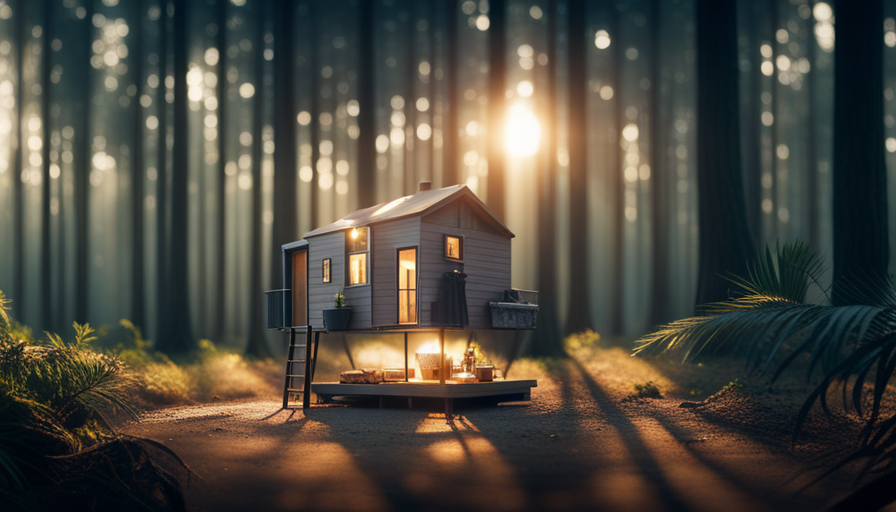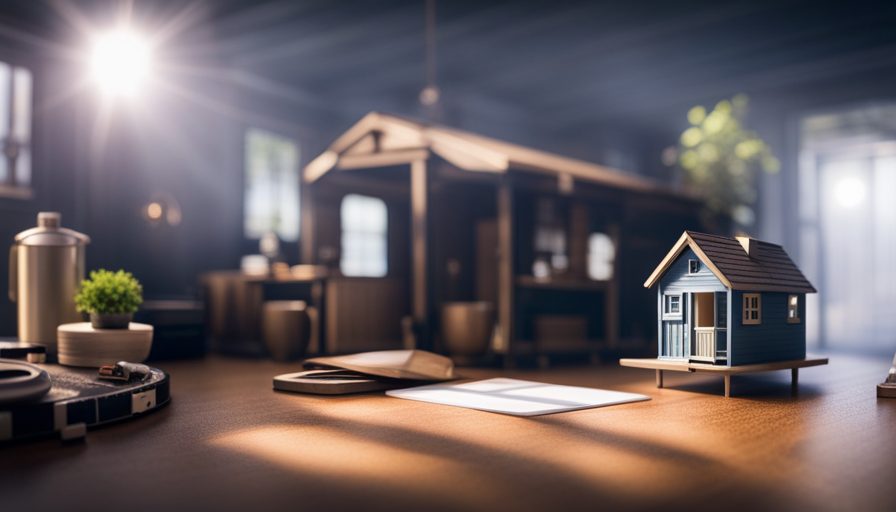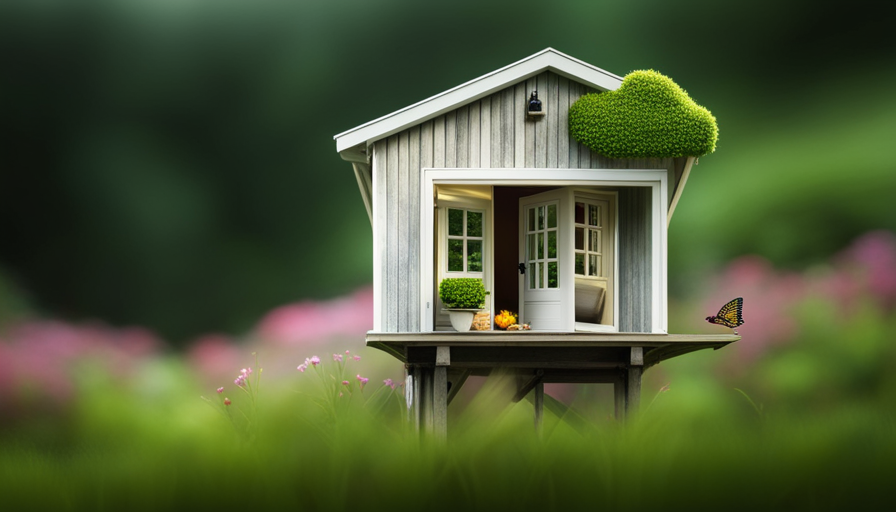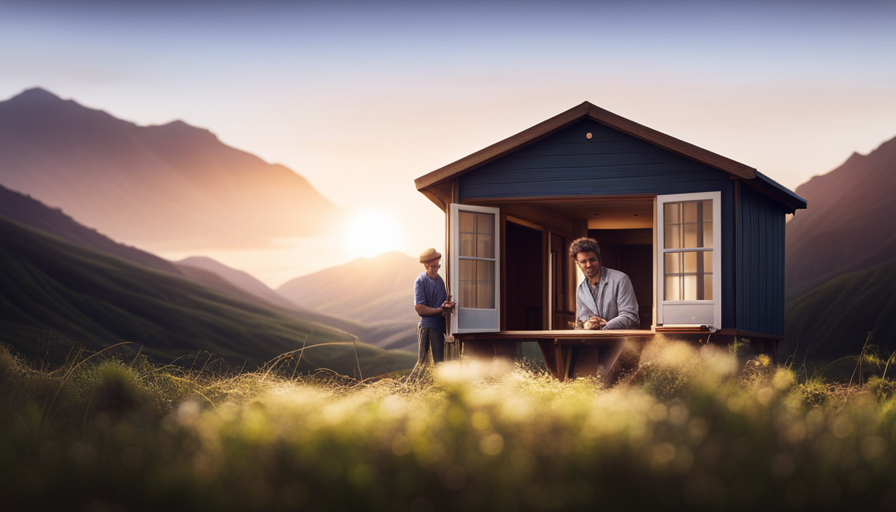Similar to a meticulously made arrow targeting the center of a target, the stature of a 16ft tiny house is an essential element that demands thoughtful attention. As someone who dreams of living in a tiny house, it’s imperative to make certain that your small home not only adheres to laws and construction standards but also aligns with your personal requirements and desires.
In this article, I will delve into the various aspects that determine the ideal height for your 16ft tiny house. From mobility and transportation concerns to functional space and design considerations, from storage and loft space utilization to the importance of natural light and windows, we will explore every facet that should guide your decision-making process.
Additionally, we will discuss the significance of aesthetics, accessibility, safety, energy efficiency, and insulation, as well as how personal preferences and lifestyle choices play a vital role in determining the perfect height for your tiny house.
So, let us embark on this journey of precision and detail to find the ideal elevation for your 16ft tiny house.
Key Takeaways
- Height of a 16ft tiny house is a critical factor that requires careful consideration due to regulations and building codes.
- Mobility and transportation considerations, such as road and bridge height restrictions, are important when planning the height of a tiny house.
- Functional space and design considerations involve maximizing limited square footage, efficient layout, and incorporating windows for natural light.
- Accessibility and safety considerations include sufficient clearance, safety features, and energy efficiency and insulation play a role in regulating temperature and reducing energy consumption.
Regulations and Building Codes
So, how high should your 16ft tiny house be? Well, let’s dive into the world of regulations and building codes to find out!
When it comes to tiny houses, regulations and building codes play a crucial role in determining the height restrictions that you must adhere to. These regulations ensure the safety and compatibility of your tiny house with its surroundings.
Most jurisdictions have specific height restrictions for structures, including tiny houses, to ensure they don’t obstruct views, sunlight, or pose a danger to public safety. These restrictions vary from one area to another, so it’s essential to research the local regulations applicable to your location.
Additionally, building codes often specify maximum heights to ensure structural integrity and safety during extreme weather conditions.
When planning the height of your tiny house, it’s crucial to consider road travel as well. Many jurisdictions have restrictions on the height of structures that can be transported on public roads. This is to prevent collisions with bridges, power lines, or other overhead obstacles. It’s important to ensure that your tiny house is within the allowable limits for road transportation to avoid any legal or logistical issues.
Now that we understand the regulations and building codes related to height restrictions and road travel, let’s explore the next aspect of tiny house living: mobility and transportation.
Mobility and Transportation
When considering the mobility and transportation of a tiny house, it’s important to take into account height restrictions for road travel. This means ensuring that the height of the tiny house is within the legal limits to avoid any issues during transportation.
Additionally, exploring options for easy transportation and moving is crucial in order to have a smooth and efficient process. This may involve researching different methods such as hiring professional movers or investing in a trailer specifically designed for tiny houses.
Consider Height Restrictions for Road Travel
Take into account any height restrictions on the roads to ensure your 16ft tiny house can travel smoothly and anxiety-free. Road restrictions, such as bridge clearances, can pose a challenge when transporting a tiny house. To help you navigate these obstacles, it is essential to be aware of the maximum height allowed on different roads and bridges. A good practice is to measure the overall height of your tiny house, including any additional structures like solar panels or air conditioning units. This will ensure that you can safely pass under bridges and overhead obstacles without causing any damage. To convey this information more effectively, refer to the table below for some common road and bridge height restrictions:
| Road/Bridge | Maximum Height Allowed (in feet) |
|---|---|
| Highway | 14 |
| Residential | 13 |
| Bridge | 12 |
Considering height restrictions is just the first step in ensuring a smooth journey for your tiny house. Explore options for easy transportation and moving.
Explore Options for Easy Transportation and Moving
To make moving your compact home a breeze, you can explore various options for effortless transportation, like gliding along as smoothly as a swan on a calm lake. Here are four key considerations to ensure easy transportation and moving of your 16ft tiny house:
-
Easy Assembly: Opt for modular construction techniques that allow for quick and simple assembly and disassembly of your tiny house. This will make it easier to transport and set up in different locations.
-
Weight Distribution: Ensure that the weight of your tiny house is evenly distributed to prevent any issues during transportation. Properly distributing the weight will help maintain stability and prevent any damage or accidents.
-
Trailer Selection: Choose a sturdy and reliable trailer that can support the weight and dimensions of your tiny house. Look for trailers specifically designed for tiny houses to ensure a secure and smooth transportation experience.
-
Hitch and Towing: Invest in a high-quality hitch system that’s compatible with your chosen trailer. Also, make sure you have a reliable towing vehicle with sufficient towing capacity to safely transport your tiny house.
By considering these factors, you can ensure that your tiny house is easy to transport and move to different locations.
With the logistics of transportation addressed, let’s now delve into the exciting realm of functional space and design.
Functional Space and Design
Creating functional space and design in your 16ft tiny house is essential to maximize the limited square footage. When it comes to functional space optimization, every inch counts. To make the most of your tiny house, consider these interior design ideas:
-
Multi-purpose Furniture: Invest in furniture that can serve multiple functions. For example, a sofa that can be converted into a bed or a table with built-in storage.
-
Built-in Storage: Utilize vertical space by incorporating built-in storage solutions. This can include shelves, cabinets, and drawers that maximize storage potential without taking up valuable floor space.
-
Efficient Layout: Carefully plan the layout of your tiny house to ensure that every area is utilized efficiently. Consider using an open floor plan to create a sense of spaciousness and flow.
Table:
| Functional Space Optimization | Interior Design Ideas |
|---|---|
| Multi-purpose Furniture | Built-in Storage |
| Efficient Layout |
By implementing these design principles, you can create a functional and aesthetically pleasing living space within your 16ft tiny house. In the next section, we will explore storage and loft space options to further maximize the use of your limited square footage.
Storage and Loft Space
Maximizing storage and loft space is crucial for optimizing the functionality and livability of your compact 16ft home. In a small space, every square inch counts, so it’s important to carefully consider storage solutions that’ll make the most of the available area.
Utilizing vertical space is key, so incorporating tall cabinets and shelving units can help maximize storage capacity. Additionally, utilizing multi-functional furniture, such as ottomans with hidden storage compartments or bed frames with built-in drawers, can provide extra storage options without taking up valuable floor space.
When it comes to loft space, it’s essential to design it in a way that allows for both comfort and functionality. Installing a loft ladder or staircase with built-in storage can provide easy access to the loft area while also offering additional storage space. Additionally, incorporating built-in shelves or cabinets into the loft area can help maximize storage options without sacrificing headroom.
Transitioning into the subsequent section about natural light and windows, it’s important to consider how the placement of windows can impact both the functionality and aesthetics of your tiny home.
Natural Light and Windows
Incorporating ample windows and natural light into the design of your compact 16ft home is essential for enhancing both the functionality and aesthetics of the space. Natural light not only illuminates the interior, making it feel more spacious, but it also has numerous health benefits, such as boosting mood and improving sleep quality. When considering window placement, it’s important to strategically position them to maximize natural light while also maintaining privacy and energy efficiency.
To achieve this balance, it’s helpful to create a table that outlines the different window options and their benefits:
| Window Type | Benefits |
|---|---|
| Skylights | Bring in abundant overhead natural light and add a unique architectural element to the space. |
| Clerestory Windows | Placed high on the wall, they allow light to enter without compromising privacy. |
| Picture Windows | Provide unobstructed views and flood the space with natural light. |
| Awning Windows | Positioned higher up, they allow for ventilation while keeping rain out. |
By incorporating a combination of these window types, you can achieve a well-lit and visually appealing interior. The placement of windows should be carefully considered to maximize natural light without sacrificing privacy. Furthermore, it’s important to choose energy-efficient windows to minimize heat loss and gain.
When it comes to ventilation and airflow, it’s crucial to create a seamless transition between sections without explicitly stating it.
Ventilation and Airflow
When designing a compact space like a 16ft tiny house, it’s crucial to plan for proper ventilation. Without adequate airflow, the space can become stuffy and uncomfortable.
To ensure comfort, I recommend incorporating ceiling fans or venting systems to promote air circulation and prevent the buildup of heat and moisture.
Plan for Proper Ventilation in a Compact Space
To ensure adequate airflow and prevent any potential issues with condensation or mold, you’ll want to carefully consider how to plan for proper ventilation in your compact 16ft tiny house.
In a compact space, ventilation is crucial, as limited square footage can lead to stagnant air and poor air quality. Start by incorporating windows strategically throughout the house. Windows should be placed in opposite walls to promote cross-ventilation.
Additionally, consider installing a skylight or roof vent to allow hot air to escape and fresh air to enter. Another option is to incorporate ceiling fans or venting systems for comfort. These can help circulate the air and create a more pleasant living environment.
By implementing these measures, you can ensure that your tiny house remains well-ventilated and comfortable for living.
Incorporate Ceiling Fans or Venting Systems for Comfort
When planning for proper ventilation in a compact space, it’s crucial to consider incorporating ceiling fans or venting systems for enhanced comfort. Ceiling fans not only provide a cooling effect, but they also help circulate the air, preventing it from becoming stagnant.
Installing a ceiling fan in a 16ft tiny house can be a practical solution as it maximizes space utilization. Additionally, there are various ventilation system options available that can be installed to ensure proper airflow. These systems can include exhaust fans, roof vents, or even whole-house ventilation systems, depending on the specific needs of your tiny house.
By strategically placing these ventilation systems, you can effectively control temperature, humidity, and air quality within the compact space. Considering the importance of comfort and air circulation, the next aspect to address is the aesthetics and exterior design.
Aesthetics and Exterior Design
When considering the aesthetics and exterior design of my tiny house, it’s important to choose a roof style that matches my preferences. Whether it’s a gable, shed, or flat roof, the choice should be based on both functionality and personal taste.
Additionally, considering architectural features such as windows, doors, and siding can greatly enhance the overall look of the tiny house, creating a visually appealing and cohesive design.
Choose a Roof Style that Matches Your Preferences
If you’re going for a cozy and rustic feel, you might want to consider a roof style that matches your preferences for your 16ft tiny house. When choosing a roof style, it’s important to consider both the aesthetics and the practicality. Different roofing materials can give your tiny house a distinct look, but you also need to take into account the cost considerations. To help you make an informed decision, here is a table comparing three popular roofing materials for tiny houses:
| Roofing Material | Pros | Cons |
|---|---|---|
| Metal | Durable and long-lasting | Expensive |
| Asphalt | Affordable and easy to install | Less aesthetically pleasing |
| Cedar Shingles | Natural and beautiful | Require regular maintenance |
Considering these factors will ensure that you choose a roof style that not only matches your personal preferences but also fits your budget and maintenance capabilities. Additionally, considering architectural features to enhance the overall look of your tiny house will further elevate its charm.
Consider Architectural Features to Enhance the Overall Look
To truly elevate the overall look of your 16ft tiny house, consider incorporating architectural features that’ll add a touch of grandeur and make your home feel like a luxurious mansion.
When it comes to architectural details, there are several options to consider. First, you can add decorative moldings and trim to the exterior of your house, creating a more refined and elegant look.
Second, consider installing stylish windows with intricate frames to enhance the aesthetics and allow for ample natural light.
Lastly, incorporating unique exterior finishes such as stone, brick, or wood siding can add texture and sophistication to your tiny house. These architectural features won’t only enhance the overall look of your home but also create a sense of luxury and charm.
Transitioning into the subsequent section about ‘accessibility and safety,’ it’s important to ensure that these architectural details aren’t only visually appealing but also functional and safe.
Accessibility and Safety
Consider constructing your 16ft tiny house with a height that allows for easy accessibility and ensures the safety of its occupants. When designing the height of your tiny house, it is important to take into account accessibility challenges and safety concerns. By incorporating architectural features that promote accessibility and prioritize safety, you can create a comfortable and secure living space.
To address accessibility challenges, it is essential to provide sufficient clearance and maneuverability within the tiny house. This includes doorways wide enough to accommodate wheelchair access, ramps or lifts for entry points, and a layout that allows for easy navigation throughout the space. Additionally, consider installing grab bars and handrails in key areas such as the bathroom to further enhance accessibility and safety.
In terms of safety concerns, it is crucial to ensure that the height of your tiny house meets building codes and regulations. This includes having adequate headroom in all areas to prevent injuries from low ceilings or beams. Additionally, consider incorporating safety features such as smoke detectors, fire extinguishers, and emergency exits to protect the occupants in case of emergencies.
By carefully considering accessibility and safety when determining the height of your 16ft tiny house, you can create a space that is both functional and secure. In the next section, we will explore the importance of energy efficiency and insulation in tiny house design.
Energy Efficiency and Insulation
After considering the importance of accessibility and safety in building my 16ft tiny house, it’s now time to delve into the realm of energy efficiency and insulation. These two factors are crucial in ensuring that my tiny house is not only comfortable but also cost-effective in the long run.
When it comes to energy efficiency, there are several aspects to consider. First and foremost, I need to prioritize the insulation of my tiny house. This will help regulate the temperature inside, keeping it warm during winters and cool during summers. Secondly, I should invest in energy-efficient appliances and lighting fixtures that consume minimal electricity. This won’t only reduce my carbon footprint but also save me money on energy bills.
To achieve optimal insulation and energy efficiency, I plan to incorporate the following strategies:
- Installing double-pane windows to minimize heat transfer
- Using spray foam insulation to seal any gaps or cracks
- Adding a layer of reflective insulation to the roof to reduce heat absorption
- Utilizing energy-efficient HVAC systems and LED lighting throughout the house
By implementing these energy-saving techniques, I can create a sustainable and comfortable living space in my tiny house.
Now, let’s explore how personal preferences and lifestyle choices can further enhance the design and functionality of my 16ft tiny house.
Personal Preferences and Lifestyle
When considering the height of my 16ft tiny house, I need to reflect on my unique needs and preferences. It’s important to customize the height of the tiny house to suit my lifestyle.
This means taking into account factors such as my height, mobility, and any specific requirements I may have. By doing so, I can ensure that the height of my tiny house is perfectly tailored to my individual needs, allowing for maximum comfort and functionality.
Reflect on Your Unique Needs and Preferences
Reflecting on my unique needs and preferences, it’s crucial to determine the ideal height for my 16ft tiny house. When considering my preferences, I need to think about my lifestyle and how I plan to use the space. Do I want a loft area for sleeping or would I prefer a single-level layout? Will I be living alone or with a partner? These factors will play a significant role in determining the height of my tiny house.
Additionally, I should consider my physical abilities and any potential restrictions. For example, if I have mobility issues, a lower height may be more practical. On the other hand, if I have a preference for higher ceilings and a more spacious feel, I may opt for a taller height.
By reflecting on my preferences and unique needs, I can customize the height of my tiny house to suit my lifestyle seamlessly.
Customize the Height of Your Tiny House to Suit Your Lifestyle
Consider customizing the height of your compact dwelling to perfectly cater to your unique lifestyle and preferences. By customizing the height of your tiny house, you can create a space that’s tailored to your specific needs.
Here are some factors to consider when deciding on the height of your tiny house:
-
Building materials: The height of your house will depend on the type of building materials you choose. For example, if you opt for lightweight materials like wood or steel, you may be able to build a taller structure without compromising stability.
-
Budget considerations: Your budget will play a significant role in determining the height of your tiny house. Taller structures may require more materials and labor, which can impact your overall budget. It’s important to weigh the cost versus the benefits of a taller dwelling.
-
Accessibility: Consider your mobility needs when deciding on the height of your tiny house. If you have any physical limitations or anticipate challenges with climbing stairs, a lower height may be more suitable.
-
Interior design: The height of your tiny house will affect the interior design options available to you. A taller structure can accommodate lofted sleeping areas or additional storage space, while a lower height may limit these possibilities.
-
Zoning regulations: Before customizing the height of your tiny house, be sure to check local zoning regulations. Some areas may have restrictions on the maximum height allowed for tiny houses.
When customizing the height of your tiny house, take into account these factors to create a dwelling that aligns with your lifestyle, budget, and design preferences.
Frequently Asked Questions
What are some common challenges when it comes to complying with regulations and building codes for tiny houses?
Common challenges when it comes to complying with regulations and building codes for tiny houses include navigating zoning laws, ensuring structural integrity, and meeting safety requirements.
Zoning laws can be complex and may restrict where tiny houses can be located.
Meeting building codes requires careful planning to ensure that the house is constructed according to the standards set by the relevant authorities.
Safety requirements involve considerations such as fire safety, electrical systems, and plumbing.
Overall, complying with regulations and building codes can be a meticulous and time-consuming process.
Are there any specific considerations for transporting a 16FT tiny house, such as weight restrictions or road clearance?
When considering the transportation of a 16ft tiny house, it’s important to take into account weight restrictions and road clearance.
Weight restrictions vary depending on the jurisdiction and type of road, so it’s crucial to ensure that the tiny house doesn’t exceed the maximum allowable weight.
Road clearance refers to the vertical space required for safe passage under bridges, power lines, or other obstacles. It’s essential to measure the height of the tiny house and compare it to the clearance requirements to avoid any potential accidents or damages.
How can I maximize the functional space and design of my 16FT tiny house to accommodate all my needs?
To maximize functionality and create a space-saving design for my 16ft tiny house, I would focus on optimizing every inch of available space.
One interesting statistic to keep in mind is that the average tiny house owner uses only 400 square feet of living space, compared to the average American home size of around 2,600 square feet.
With this in mind, I would implement clever storage solutions such as built-in cabinets, multi-functional furniture, and utilize vertical space with lofted sleeping areas or overhead storage compartments.
Additionally, incorporating space-saving techniques like hidden pull-out surfaces or collapsible furniture can further maximize the usable space in my tiny house.
By carefully planning and considering my specific needs and lifestyle, I can design a functional and efficient living space within the constraints of a 16ft tiny house.
What are some creative storage solutions for a 16FT tiny house, considering limited space?
When it comes to creative storage solutions and space-saving ideas for a 16ft tiny house, there are several options to consider.
Utilizing vertical space is key, so installing shelves or cabinets that reach up to the ceiling can maximize storage capacity.
Additionally, utilizing multifunctional furniture, such as beds with built-in storage or collapsible tables, can save valuable space.
Incorporating hidden storage compartments and utilizing wall space for hanging organizers can also help optimize the limited space available.
What are the best strategies for maximizing natural light and incorporating windows in a 16FT tiny house design?
Imagine your tiny house as a radiant sunflower, absorbing the sunlight and blooming with natural light. Maximizing natural light and incorporating windows is crucial in creating a bright and airy space.
Strategically placing windows on all sides of the tiny house allows for optimal light penetration. Consider using larger windows on the south-facing side to capture the most sunlight. Skylights and transom windows can also be employed to introduce additional light from above.
Conclusion
In conclusion, after careful consideration of regulations, mobility, functional space, storage, natural light, aesthetics, accessibility, energy efficiency, and personal preferences, it’s clear that determining the height of a 16ft tiny house is a crucial decision.
By striking the perfect balance between all these factors, we can create a harmonious living space that’s both practical and visually stunning.
So, remember, when it comes to the height of your tiny house, aim for the sky and let your dreams soar like a majestic eagle in flight.
Hi, I’m Emma. I’m the Editor in Chief of Tiny House 43, a blog all about tiny houses. While tree houses are often associated with childhood, they can be the perfect adult retreat. They offer a cozy space to relax and unwind, surrounded by nature. And since they’re typically built on stilts or raised platforms, they offer stunning views that traditional homes simply can’t match. If you’re looking for a unique and romantic getaway, a tree house tiny house might just be the perfect option.










